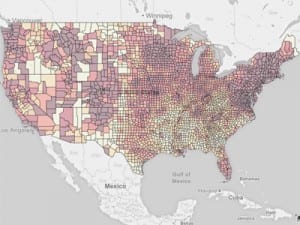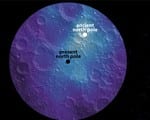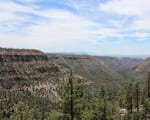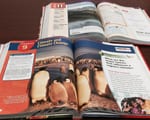SMU’s National Center for Arts Research (NCAR) releases Second Annual Arts Vibrancy Index

SMU’s National Center for Arts Research (NCAR) today released its second annual Arts Vibrancy Index, which ranks more than 900 communities across the country, examining the level of supply, demand, and government support for the arts in each city. This year, the report features six new communities, with three states – Hawaii, Oregon and Texas – appearing in the index for the first time. The new cities featured on the lists are Portland, Oregon; Austin, Texas; and Kansas City, Missouri, in the top 20 large cities list; and Maui, Hawaii; St. Cloud, Minnesota; and Medford, Oregon, in the top 20 small and medium cities list. NCAR provides rank scores on all measures for every U.S. county on its interactive heat map.
“Each community in the report has a unique story and cultural landscape – this report is designed to help us understand what makes a city vibrant in the arts and the different elements that come into play to foster that vibrancy,” said Zannie Giraud Voss director of NCAR, and chair and professor of arts management and arts entrepreneurship in SMU’s Meadows School of the Arts and Cox School of Business. “The data helps illustrate how vibrancy varies between cities and what arts vibrancy looks like for different communities around the nation.”
The overall index is composed of three dimensions. Supply is assessed by the total number of arts providers in the community, including the number of arts organizations, independent artists, and arts, culture, and entertainment employees. Demand is gauged by the total nonprofit arts dollars in the community, including program revenue, contributed revenue, total expenses, and total compensation. Lastly, the level of government support is based on state arts dollars and grants and federal arts dollars and grants.
Geographically, the rankings utilize Micro- and Metropolitan Statistical Areas (MSAs), which are delineated geographic areas consisting of one or more counties that have high social and economic integration with an urban core as defined by the Office of Management and Budget (OMB). By focusing on MSAs, the index captures the network of suburbs that rise up around a city or town rather than considering each separately. Where the OMB breaks down very large MSAs into Metropolitan Divisions, this report does, too.
Among cities with populations of 1 million or more, the five most vibrant arts communities are as follows:
- Washington-Arlington-Alexandria, DC-VA-MD-WV
- Nashville-Davidson-Murfreesboro-Franklin, TN
- New York-Jersey City-White Plains, NY-NJ
- San Francisco-Redwood City-South San Francisco, CA
- Los Angeles-Long Beach-Glendale, CA
Portland, Oregon; Austin, Texas; and Kansas City, Missouri joined the top 20 list this year, ranked 17, 18, and 19, respectively. Compared to 2015, there was little movement between the highest-ranking cities in both the larger and smaller markets, and the top three cities remain the same as last year, with some repositioning between them. In the top five rankings among large cities, the biggest mover was Los Angeles, which moved up to fifth place from its position in ninth place last year; San Francisco moved up to fourth place (from fifth); and Boston dropped down two positions to sixth place.
For medium and small cities, with populations under 1 million, the top five cities are all in the West. Jackson, Wyoming, which ranked third in last year’s index, has moved to the top of the list from its former position in third place, causing Glenwood Springs, Colorado, and Santa Fe, New Mexico, to drop down one position to second and third respectively:
- Jackson, WY-ID
- Glenwood Springs, CO
- Santa Fe, NM
- Breckenridge, CO
- Edwards, CO
Three new cities appear in the top 20 medium and small cities list: Maui, Hawaii; St. Cloud, Minnesota; and Medford, Oregon, ranked at 14, 16, and 20, respectively. The full top 20 lists are available on the NCAR website, including scores on each of the three dimensions (supply, demand, and government support).
Beyond the specific rankings, select key findings in the Arts Vibrancy Index include:
- Every region of the country is represented on both lists: no region has cornered the market on arts vibrancy. Cities large and small from every region appear in the top 40 cities, although there is high representation from Western and Midwestern communities in the set of medium-small cities.
- Arts vibrancy takes many shapes and forms. Some cities have impressive financial resources invested in nonprofit arts and cultural institutions, others are filled with many smaller organizations and venues, some are tourist destinations, and still others are artist colonies. Some cities are strong in numerous arts sectors while others are capitals of a particular art form.
- Vibrancy in very large cities takes two distinct forms: some cities feature a strong concentration of arts vibrancy in the urban core with less happening in the surrounding areas, while others feature an even distribution of vibrancy across their metropolitan areas.
The majority of arts-vibrant cities have a population either under 300,000 or between 1,000,000 and 3,000,000.
About NCAR
In 2012, the Meadows School of the Arts and Cox School of Business at SMU launched the National Center for Arts Research (NCAR). The Center, the first of its kind in the nation, analyzes the largest database of arts research ever assembled; investigates important issues in arts management and patronage; and makes its findings available to arts leaders, funders, policymakers, researchers and the general public.
Follow SMUResearch.com on twitter at @smuresearch.
SMU is a nationally ranked private university in Dallas founded 100 years ago. Today, SMU enrolls nearly 11,000 students who benefit from the academic opportunities and international reach of seven degree-granting schools. For more information see www.smu.edu.
SMU has an uplink facility located on campus for live TV, radio, or online interviews. To speak with an SMU expert or book an SMU guest in the studio, call SMU News & Communications at 214-768-7650.


 NASA data leads to rare discovery: Earth’s moon wandered off axis billions of years ago
NASA data leads to rare discovery: Earth’s moon wandered off axis billions of years ago Good news! You’re likely burning more calories than you thought
Good news! You’re likely burning more calories than you thought New look at Pizarro’s conquest of Inca reveals foot soldiers were awed by empire’s grandeur
New look at Pizarro’s conquest of Inca reveals foot soldiers were awed by empire’s grandeur Charity, social justice and earth-friendly activism replace big houses, diamond rings and ostentatious living for status seekers
Charity, social justice and earth-friendly activism replace big houses, diamond rings and ostentatious living for status seekers National Center for Arts Research white paper counters findings of the Devos Institute Study on Culturally Specific Arts Organizations
National Center for Arts Research white paper counters findings of the Devos Institute Study on Culturally Specific Arts Organizations Long-term daily contact with Spanish missions triggered collapse of Native American populations in New Mexico
Long-term daily contact with Spanish missions triggered collapse of Native American populations in New Mexico North America’s newest pterosaur is a Texan — and flying reptile’s closest cousin is English
North America’s newest pterosaur is a Texan — and flying reptile’s closest cousin is English California 6th grade science books: Climate change a matter of opinion not scientific fact
California 6th grade science books: Climate change a matter of opinion not scientific fact Reading ability soars if young struggling readers get school’s intensive help immediately
Reading ability soars if young struggling readers get school’s intensive help immediately